
Myrmica rubra, also known as the European fire ant or common red ant, is a species of ant of the genus Myrmica, found all over Europe and is now invasive in some parts of North America and Asia. It is mainly red in colour, with slightly darker pigmentation on the head. These ants live under stones and fallen trees, and in soil. They are aggressive, often attacking rather than running away, and are equipped with a sting, though they lack the ability to spray formic acid like the genus Formica.
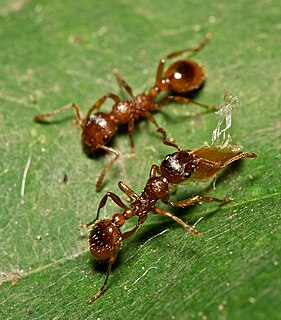
Myrmica is a genus of ants within the subfamily Myrmicinae. It is widespread throughout the temperate regions of the Holarctic and high mountains in Southeast Asia.
Myrmica cadusa is a species of ant. Myrmica cadusa differs from similar ants in the genus Myrmica by the external shape of the antennal socket, which is jar shaped. They forage on the ground surface. Myrmica are unique from other types of ants in many ways. These are their oval head, rounded clypeus, prominent frontal lobes and in most species, a strongly developed propodeal spine with two large nodes.

Myrmica colax is a species of ant, originally described by Cole as Paramyrmica colax. Until now, it is only known from its type locality in the Davis Mountains, Texas, USA. He found M. colax in a M. striolagaster colony and considers the two species quite similar in morphology. This suggests M. colax might be an inquiline.

Harpagoxenus is a genus of ants in the subfamily Myrmicinae. Found in the Palaearctic and Nearctic ecozones of the world, Harpagoxenus was first established as Tomognathus by Mayr (1861) to house the species Myrmica sublaevis. However, the name had already been used (homonym) for a genus of fish, and was replaced with its current name by Forel (1893).
Myrmica faniensis is a species of ant in family Formicidae. It is endemic to Belgium. However, it should be considered a junior synonym of Myrmica karavajevi .
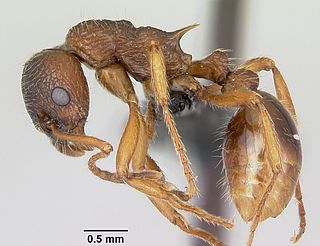
Myrmica ruginodis is a species of ant that lives in northern parts of Europe and Asia. It is very similar to M. rubra, but has a more northerly and higher-altitude distribution. Overwintering larvae may become either workers or queen ants, with up to 20 queens living in a colony of up to 2,500 individuals. Two subspecies are recognised, differing in the relative size of the queen.

Myrmica scabrinodis is a Euro-Siberian species of ant. It lives in moderately humid habitats, tolerates soil moisture but also needs direct sunshine. It often inhabits peat bogs. It builds nests in the ground, in grass or moss tussocks, even under stones or in rotten wood. Its colonies are monogynous or have only a few queens and may contain about 2500 workers. This ant species is the main host of the entomopathogenic fungus Rickia wasmannii. Phengaris caterpillars are primary threats of M. scabrinodis with specific species such as Phengaris arion developing a predatory relationship.

Myrmica lonae is a species of ant distributed across South, Central and North Europe, East Europe, Asia Minor, the Caucasus, West Siberian Plain and Northern Kazakhstan. It inhabits humid meadows both in the plains and in the mountains. It nests in the ground, under stones or in moss. It forms polygynous colonies with up to 1000 workers or more.

Myrmica vandeli is an ant species found sporadically across several European countries. It often coexists with M. scabrinodis. It lives in open, wet meadows. Nests are typically constructed in moss pads. Polygynous colonies may contain 1500 workers. Larvae of Phengaris butterflies may parasitize their colonies.
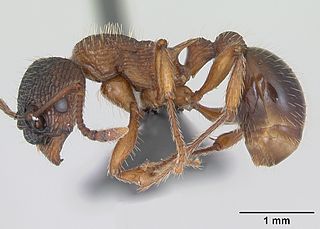
Myrmica schencki is a species of ant in the genus Myrmica.

Myrmica gallienii is an ant species distributed from Central Europe to West Siberia. Also found in Sweden, Finland, Hungary, Bulgaria and Romania. It lives in wet grasslands and swamps, often in saline land. It builds shallow nests with a soil mound in moist habitats but deep nests in sandy areas. Colonies are relatively large with thousands of individuals.

Myrmica lobicornis is an ant species distributed through the planes of North Europe and the mountains of Central and Southern Europe. It is also found in the forest zone of East Europe, the Caucasus, West Siberia, North-East Kazakhstan, East Siberia, and Mongolia stretching until Transbaikalia in the East. It inhabits coniferous or mixed woodlands, occasionally also meadows. It mostly nests in the ground, forms monogynous colonies containing a few hundred workers.

Rickia wasmannii is a species of the widely distributed entomoparasitic order of fungi Laboulbeniales. It is an obligatory ectoparasite of ants of the genus Myrmica. The thalli penetrate outer layer of the cuticle, and appear on the host body surface. Little is known about its effect on the host ant, but it is usually regarded as a rather neutral symbiont. Contrarily, however, a recent study has documented an increased need of drinking water and a shortened life-span of infected ants.

Burmomyrma is an extinct genus of ant-mimic wasp in the extinct family Falsiformicidae. The genus contains a single described species, Burmomyrma rossi. Burmomyrma is known from a single Middle Cretaceous fossil which was found in Asia.

Myrmica elmesi is a species of ant in the subfamily Myrmicinae. The species, known from north-west Himalaya, belongs to pachei group, and is significantly different from all other described species of this group.

Myrmica salina is a species of ant belonging to the genus Myrmica. They have a wide distribution in Europe and Siberia, as well as being abundant to several former republics of the Soviet Union, where their preferred habitats are relatively wet halophyte biotopes. Ruzsky first described the first specimen of the species in 1905.
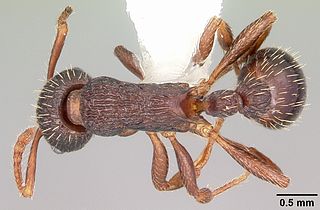
Myrmica spatulata is a species of ant in the family Formicidae. It is found in the forests of the middle and eastern part of the United States.
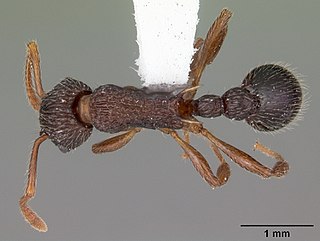
Myrmica punctiventris is a species of ant in the family Formicidae.

















